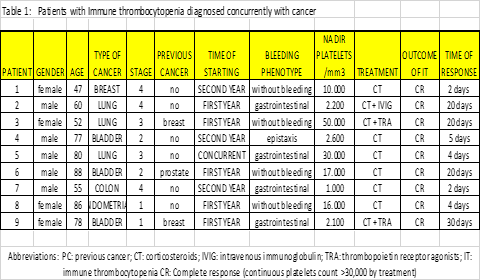
Contributions
Abstract: PB2099
Type: Publication Only
Background
Aims
We report our experience of 10 years at a single hospital in Spain, in patients with IT concurrent with neoplasia.
Methods
We identified the patients by data search of hospital records from 2006 to 2016, with diagnosis of IT with previous diagnosis of cancer, not related with chemotherapy or radiotherapy, not suggestive of bone marrow infiltration, drug-induced, infection of disseminated intravascular coagulation. For the diagnosis, the examination of bone marrow was not mandatory.
Results
The two most common cancers associated with IT were bladder and lung neoplams, but the occurrence of prior cancer (third part of patients) was not uncommon. The IT can appear at any stages of cancer, and it is mainly detected at the first two years after the diagnosis when the patient have been in acceptable antitumoral response. They usually manifest with very low platelet count <20.000, but not always with evident clinical bleeding. The response to therapy was fast and complete with corticoids (usually in the first week) in the majority of patients, but some cases require the combination second line with immunoglobulins or thrombopoietin receptor agonists, and in the follow-up, the response was persistent without recurrence in the first year post-treatment.

Conclusion
The CAIT is a rare hematological paraneoplastic syndrome that occur in solid tumors, usually associated to low platelet count but without life-threatening bleeding, requiring therapy with corticosteroids as first line, and generally related with a benign clinical course with a rapid and persistent response.
Session topic: 32. Platelets disorders
Keyword(s): Immune thrombocytopenia (ITP), Cancer
Abstract: PB2099
Type: Publication Only
Background
Aims
We report our experience of 10 years at a single hospital in Spain, in patients with IT concurrent with neoplasia.
Methods
We identified the patients by data search of hospital records from 2006 to 2016, with diagnosis of IT with previous diagnosis of cancer, not related with chemotherapy or radiotherapy, not suggestive of bone marrow infiltration, drug-induced, infection of disseminated intravascular coagulation. For the diagnosis, the examination of bone marrow was not mandatory.
Results
The two most common cancers associated with IT were bladder and lung neoplams, but the occurrence of prior cancer (third part of patients) was not uncommon. The IT can appear at any stages of cancer, and it is mainly detected at the first two years after the diagnosis when the patient have been in acceptable antitumoral response. They usually manifest with very low platelet count <20.000, but not always with evident clinical bleeding. The response to therapy was fast and complete with corticoids (usually in the first week) in the majority of patients, but some cases require the combination second line with immunoglobulins or thrombopoietin receptor agonists, and in the follow-up, the response was persistent without recurrence in the first year post-treatment.

Conclusion
The CAIT is a rare hematological paraneoplastic syndrome that occur in solid tumors, usually associated to low platelet count but without life-threatening bleeding, requiring therapy with corticosteroids as first line, and generally related with a benign clinical course with a rapid and persistent response.
Session topic: 32. Platelets disorders
Keyword(s): Immune thrombocytopenia (ITP), Cancer


